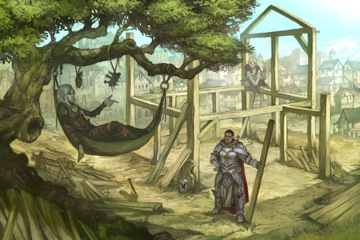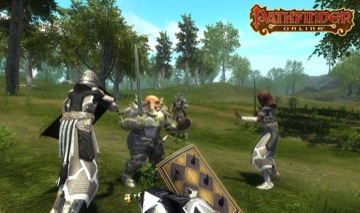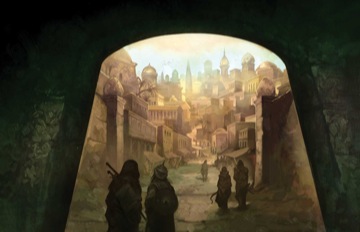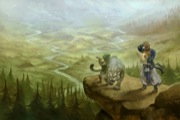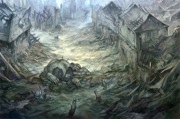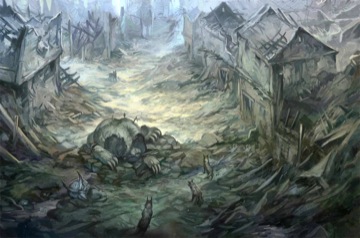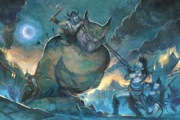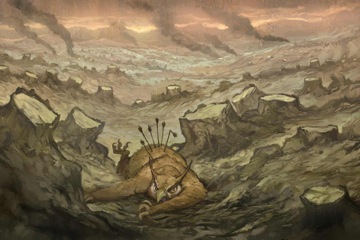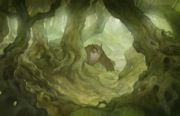When we first started brainstorming for Pathfinder Online (PFO), I was running the Kingmaker Pathfinder Adventure Path in my home gaming group. We were loving the idea of adventurers forging a kingdom out of the wilderness. It gave an extra dimension and purpose to our adventures, along with an additional set of problems to roleplay through.
So when Ryan and I started to think about PFO, I felt that Kingmaker's setting, the River Kingdoms of Golarion, would be the perfect backdrop for an MMORPG: a cluster of small settlements and kingdoms battling the environment and each other for survival. It would be like playing Kingmaker in coordination with dozens of other gaming groups, with each GM sharing info on what his group is doing, and occasionally the groups would get together and either help or hinder each other. In the Pathfinder RPG, coordinating such a campaign would be a massive feat, but MMORPGs are perfectly set up for just such a scenario, so that's what we're building with PFO.
Starting in a little less than two months, PFO players, much like their table-top counterparts, will be able to pick and choose how their settlements are going to be built, developing it all with their own sweat and blood. There will be dozens and dozens of buildings to choose from, and you'll be able to upgrade many of those buildings over time. Will you put up walls? How about a community garden? What deities will your temple support? There will be a legion of decisions, making each settlement as unique as any character.
Right now, you can claim a hex in the game and put up holdings and outposts. In a few weeks, you will be able to contest the claims of others, possibly claiming those holdings for yourself, or burning them to the ground. Remember in the Kingmaker AP when you heard that one of your lumber camps was being attacked and you had to intervene? Well, the same thing will happen in PFO to your lumber camp, or your mine, or any other holding. Defend them, or there will be consequences.
The Political Landscape
One of the unique things about playing in a sandbox MMO is that the players themselves build the things that exist in the world. To jumpstart that effort, we did a Land Rush a few months after the Kickstarter ended, and 30 player settlements were handed out to the 30 groups that had the most players pledging to them. This gave us the starting player settlement landscape for when the game launched. You can check out the current map of the game world, created by one of the players in the game, here.
Once settlement warfare comes into the game and you are able to destroy a settlement or conquer it, this map will change. Already, there are some areas of the world that are more powerful and populated than others. Here is a snippet of the political landscape as it exists today.
The biggest and most powerful alliance in the game is the Everbloom Alliance, or EBA. Made up of the settlements of Brighthaven, Phaeros, Keeper's Pass, Hammerfall and Blackwood Glade; the purpose of the alliance is protection of its member settlements and their members.
EBA's arch-nemesis, the second most powerful alliance in the game, is the Empire of Xeilias, made up of the member settlements of Golgotha, Callambea, Kreuz Bernstein, and Auroral. They are led by their Benevolent Dictator Phyllain, and are the most active PVP contingent. Located in the center of the game map, their exploits against the EBA have already become the stuff of legend in the world.
In the northwest corner of the map lies the third most powerful alliance in the game, the Coal Road Alliance, aka The High Road Covenant. Comprised of the settlements of Stoneroot Glade, Talonguard and Taverhold, they have provided a bastion for folks wanting to steer clear of the drama taking place between EBA and Xeilias. The community there is super-supportive and actively campaigns against the monsters in the area.
In the north, we have the Free Highlanders, consisting of Alderwag, the paladins of Ozem's Vigil, and the dwarves of Forgeholm. This group provides support for each other through trade and defense, especially when troubles flared up between them and Golgotha a month or so back.
Currently, the last significant alliance is the Aeonian League, consisting of Hope's End, Sunholm, and Canis Castrum. For the most part, they have kept to themselves out in the middle western part of the map, with Canis Castrum making a run to become the most significant market town on the western half of the map.
The southwestern corner of the map is a ghost town of hexes overrun with monsters and abandoned settlements and is avoided by most—which will soon mean opportunity for others!
The Emerald Lodge
This leaves the largest non-allied settlement in the game, The Emerald Lodge. Run by Thod, the Emerald Lodge is situated smack-dab in the middle of the map, between the warring factions of the EBA and the Empire of Xeilias. This has made for some harrowing times for Thod and his settlement, but to date, they have navigated the politics, made deals where they had to, and kept themselves viable and thriving in the game without joining one of the larger player blocs.
Player Spotlight: Thod
Five-star Pathfinder Society GM Jens Loesel gives us insight into Pathfinder Online from the point of view of a Pathfinder RPG player, father of two, and the leader of the largest non-alliance group in the game, the Emerald Lodge.
In his own words:
One of the interesting aspects of a sandbox game is that you can play your own game, bound only by the sand, the other players, and the technology. There is a lot of freedom as a player. And that is what attracted me to Pathfinder Online.
Because I wanted to give everything a Pathfinder Society background, in the early days my main character was Theodum, designed after my very first PFS character. Theodum earned the title of Venture-Captain in the Eyes of the Ten, and now the things he does in Pathfinder Online feed back into his character at the PFS table.
Lately, my dwarf character Thod has taken much of my time. He started as a gatherer because that's probably the most important role to kickstart a settlement economy. Encroaching monsters and the need for victory tokens led to Thod training in fighting, which also makes him fun to play with groups that need someone who can kill monsters in the wild. Most people associate me with Thod now, especially as I post as Thod in my blogs. (A lot of the time I "play" as Thod is actually outside of the game.)
My background as a Pathfinder Society player and 5-Star Game Master in the United Kingdom was invaluable in the Land Rush. To earn a settlement, you needed votes from other players, so I created a background for my proposed settlement that would tie it to the Pathfinder Society. I proposed the Emerald Lodge as a Pathfinder Society lodge located near the Emerald Spire superdungeon. (In game, the Emerald Spire can't yet be explored, but it can be seen, and my son was the first player to see it—or at least to report seeing it—so being close has advantages.) With this background in place, I asked UK PFS players to back me in the Land Rush, which they did. But securing a settlement was only the beginning.
My first nasty surprise came in the first week of the Land Rush, well before anyone was actually able to log into the game. Golgotha, the largest evil group, wanted to position their settlement in a spot that would make them our neighbors. We had several options: join or ally with them; find someone stronger to ally with and hope for their protection; move elsewhere and say goodbye to the background story about being next to the Spire; or ensure that they valued your settlement more alive than dead.
Meanwhile, the Everbloom Alliance was staking out a spot to the other side, albeit further away. This opened up more problems and more options. Do we get between the two, becoming a speedbump when we are overrun, or can we steer a neutral way out of the whole situation? Either side might or might not want us, but they also don't want us to join the opposition. They also don't want the bad publicity from squashing a small, harmless, innocent settlement.
What followed was a year of diplomacy, plotting, building, and interacting with other players. PFO is not just "log in, kill a few monsters, be done." Whatever you do, in game or out of game, has an effect. At times it was a balancing act, especially when we had to take some towers for ourselves or when we tried to ensure nobody tread on our toes. But we are still there. We still have all our towers and, most surprisingly for a lot of gamers, we carved out an oasis between much larger groups that are keen on PvP, yet not only do they let us play our game, they sometimes even support us. We are still around and we plan to be around a lot longer.
There's still a lot to look forward to: growing the settlement further, getting rid of towers... and building our own vision of a Pathfinder Lodge, defended by diplomacy and not force, becoming a neutral meeting point when war rages around us. Oh—and one day being among the first to go down the Spire.
Lisa Stevens
CEO






